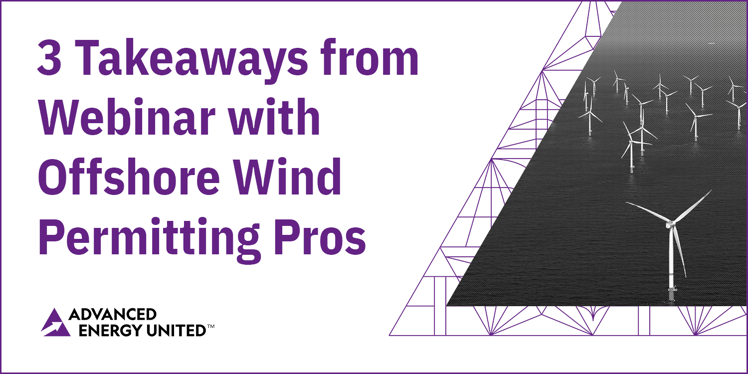
Navigating the complexities of permitting for U.S. offshore wind projects requires strategic collaboration among diverse stakeholders. To avoid project delays, and to enable large-scale strategic approval processes to happen rapidly, a coordinated effort between the federal government, regulators, developers, and stakeholders is required.
But, how can this be done?
On April 2nd, I had the opportunity to moderate a webinar discussion hosted by Reuters exploring this very topic, specifically: how do we streamline decision-making and the permitting process to create a supportive ecosystem for offshore wind projects? I was joined by a group of all-star panelists each of whom is extremely knowledgeable and experienced in this space: Pilar Patterson of Ørsted (an Advanced Energy United member), Stephanie Wilson of Atlantic Shores, Jennifer Flood of Southcoast Wind, and Hollie Emery of the Massachusetts Office of Coastal Zone Management.
Throughout the discussion, we covered an array of topics ranging from permitting complexities, robust procedures of developers during the permitting process, and monitoring and mitigating solutions. This led me to a few key takeaways that I’ve highlighted below. (Please note that these are my own reflections from the discussion and don’t reflect the specific positions or thoughts of the panelists).
Three Key Takeaways from Webinar:
- All parties benefit from a thorough, predictable permitting process
While many of us want to see efficient, speedy permitting for offshore wind projects, we can’t lose sight of the value of the process. Getting it right matters when we are talking about large scale projects at sea; there is a host of complexities and potential impacts, and our regulatory agencies are charged with finding a balance among the many interests who benefit from our offshore and onshore spaces. Thus, it isn’t about finding shortcuts; rather it’s about finding efficiencies and predictability for all parties.
One notable tool is the Bureau of Ocean Energy Management’s Notice of Intent (NOI) Checklist, which was released last summer and sets out guidelines for project developers to initiate the environmental review process, as a great resource as developers seek to craft a roadmap for projects.
- Importance of early engagement and collaboration
Meeting with federal and state regulators early on in the permitting process to introduce the project and the goals of the developer is invaluable. Building a level of mutual respect and trust between the developer and agencies at play can help create a path to success.
Collaboration at every level is vital for getting offshore wind projects from start to finish. Finding ways to improve the process for all parties – including developers, state agencies, regulators, and stakeholders – benefits all involved and accelerates the speed at which these projects get connected to our grid.
While developers compete for projects, there are opportunities for them to share some data, and leverage the successes and shortcomings of previously completed projects. This could include coordination surrounding pre-construction monitoring processes to ensure work is not duplicated and is beneficial for all involved. In addition, the continued exchange of knowledge among different state agencies is another area where everyone can work together to serve several states and projects moving forward.
- Adaptability is essential
Because of the complexity around developing, constructing, and operating offshore wind projects, change throughout the permitting process is inevitable. The challenge is to strike the right balance between predictability and accountability while still incorporating space for adaptation during the robust review that meets state and federal requirements. Allowing flexibility for technological advancements, unforeseen barriers, and changes in the landscape through mechanisms for adaptive management will help to set realistic yet efficient timelines for permitting.
How does Advanced Energy United play a role in improving the offshore wind permitting process?
At Advanced Energy United, we’re working with offshore wind and transmission developers and all the companies we need to create a 100% clean-energy future to find policy solutions that work for both communities and industries. One example of our work happened here in my state of Massachusetts where I served on the Clean Energy Infrastructure Siting and Permitting Commission, which issued its final recommendations to Governor Healey on April 1st. By advocating for smoother regulatory processes, and by encouraging regional collaboration, we aimed to create regulatory environments that make it more efficient to connect offshore wind, transmission, and other clean energy projects to the grid without compromising the integrity of the process.
